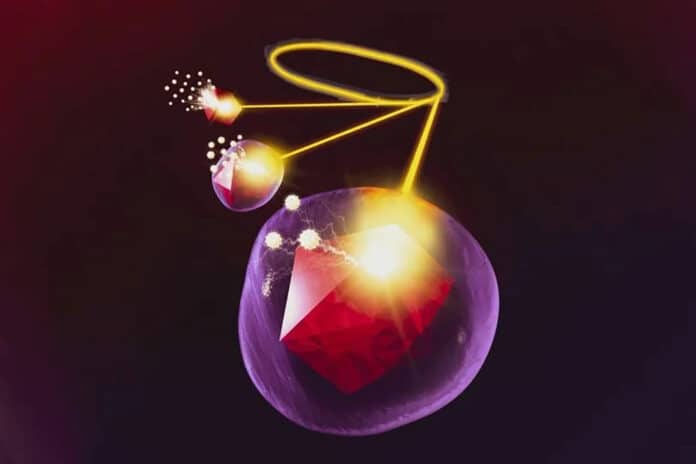With the development of quantum computing and quantum sensing platforms, the surface chemistry of materials that house quantum bits, such as diamond, is a crucial area to investigate. A possible method to incorporate room temperature quantum bits into photonic devices, fiber optics, cells, or tissues with flexible functionalization chemistry is to interface diamond in general and nanoscale diamond (ND) in particular with silica. It has been effective to use silica growth on ND cores for quantum sensing and biolabeling, but the mechanism at the surface that starts growth still needs to be recognized.
San Jose State University (SJSU) researchers report that alcohol chemical groups on a diamond’s surface are responsible for usefully uniform silica shells. This study could help them create better silica-coated nanodiamonds – tiny tools with applications from the biolabeling of cancer cells to quantum sensing.
Scientists unraveled the bonding mechanism using powerful X-rays generated by the Stanford Synchrotron Radiation Lightsource (SSRL) at the DOE’s SLAC National Accelerator Laboratory.
Abraham Wolcott, the study’s principal investigator and an SJSU professor, said, “Now that we know these finer details – how the bond works instead of just guessing – we can better explore new diamond hybrid systems.”
Although nanodiamonds should have complete carbon lattices, sometimes a nitrogen atom manages to replace a carbon atom near a missing carbon atom. Although it is technically a flaw, nanodiamonds have a variety of uses since the defect responds to magnetic fields, electric fields, and light at ambient temperature. They can serve as qubits, the fundamental building block of a quantum computer. They glow red when exposed to green light, allowing biologists to embed them in living cells and monitor their movement.
Nanodiamonds, however, are difficult to control because of their sharp edges, which might damage cell membranes. Both issues can be resolved by coating them in silica. Sharp edges are protected by a homogeneous, smooth shell made of silica. Additionally, it produces a surface that can be modified, allowing scientists to add tags to steer particles toward particular cells, such as cancer cells or neurons.
Wolcott said, “The diamond with silica shell becomes a controllable system.”
“But for some time, scientists have disagreed on how that shell forms. We showed that ammonium hydroxide with ethanol, chemicals normally included in the coating process, produces many alcohol groups on the nanodiamond surface, and those alcohols facilitate the shell’s growth.”
“Nobody could explain it for over ten years, but we could tease that information.”
Scientists at the DOE’s Lawrence Berkeley National Laboratory Molecular Foundry examined the particles using transmission electron microscopes before exploring the surfaces of the nanodiamonds with SSRL X-rays.
The chemical groups on the nanodiamonds’ surfaces were identified using SSRL’s transition edge sensor. This super-sensitive thermometer detects temperature changes and converts them to X-ray energy.
The team produced mobile electrons on the nanodiamond surface using a second technique called X-ray absorption spectroscopy (XAS), then captured them as they exited through the silica shell. The thicker the coating, the fewer electrons made it to the surface. The signals served as a nanometer-scale measuring tape, displaying the thickness of the silica covering.
Wolcott said, “XAS is powerful because you can detect something submerged, hidden – like a diamond underneath a silica shell. Folks have never done this with nanodiamonds before, so in addition to figuring out the bonding mechanism, we’ve also shown that XAS is useful for material scientists and chemists.”
Karen Lopez, a biomedical engineering PhD student at the University of California, Irvine who, like the other SJSU authors, worked on the study as an undergraduate, said, “Now that we understand how the silica shell forms, we can begin optimizing it and expanding to other types of materials.”
Journal Reference:
- Perla J. Sandoval, Karen Lopez et al. Quantum Diamonds at the Beach: Chemical Insights into Silica Growth on Nanoscale Diamond using Multimodal Characterization and Simulation. ACS Nanosci. Au. DOI: 10.1021/acsnanoscienceau.3c00033
